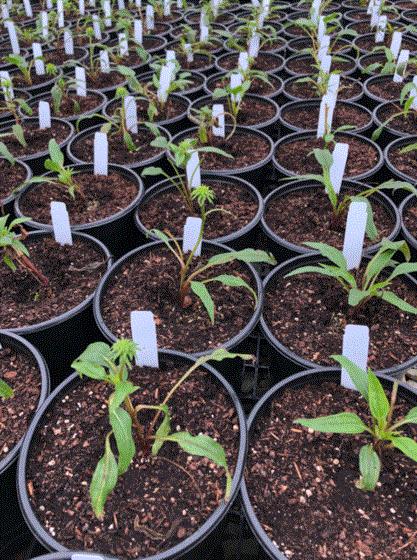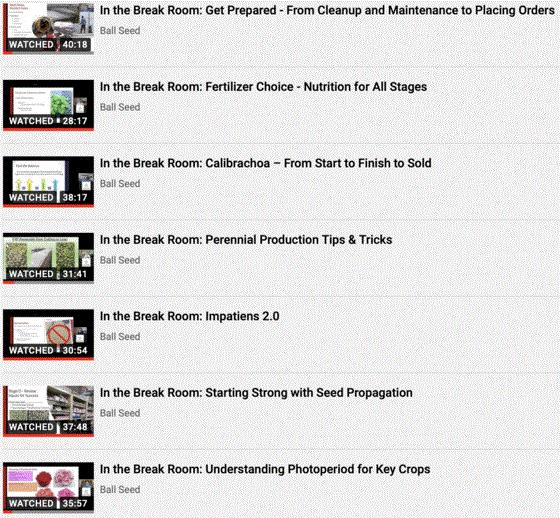Echinacea Initiating Too Early?
Not to steal any thunder from Paul Pilon's excellent Perennial Pulse newsletter, but I'm going to start off this week with a perennial: Have you encountered challenges with echinacea initiating flower buds too quickly after transplant? There are ways to approach this physically, using PGRs, and with lighting.
Here are some tips, using the crop in the photo as an example:

- First, trim all the buds off. Be sure to get even the smallest of buds off to allow for some bulking before flowering.
- An application of B9/Cycocel at 2500/500 ppm may be beneficial, as well.
- Finally, grow them under normal daylength, avoiding long days as much as possible.
See if that doesn't do the trick!
Nick's Tip of the Week: Mammoth Petunia Syndrome
Each week, I’ll work with my partner in crime Nick Flax, one of the newest technical services experts at Ball, to share a concern that’s come up during one of his numerous calls with growers across North America. This week he’s diving into petunia nutrition:

Problem: Growing combos and baskets can be tough when you have multiple species in the same container, resulting in one plant taking over the pot. This week, a grower reached out to me with petunias overtaking the other plants, and they wanted to know where they went wrong. Crops have been grown relatively cool; they’ve supplemented micronutrients to combat high alkalinity encountered in the past; plants have been well-fed, and they’ve established thorough wet-to-dry cycles. Sounds like generally good production practices, right? So how did these petunias develop into such mammoth plants while everything else stayed so small?
Nick’s Tip: As soon as I saw the photo, I thought, “Aaah, fertilizer gremlins! You must have fed them after midnight, right?” The first question was about choice of fertilizer, and the grower’s response was that they typically use a “petunia feed.” However, they ran out and, rather than using the Cal-Mag that they had on-hand until they could get more in, they used 20-20-20 for a couple of weeks.
Bingo!
Growing cool to promote toned growth is a good strategy overall, but when you do it from the get-go with a combo that has petunias (which can be grown quite cool) and warm-weather annuals, the petunias will get established quickest. This gives the petunias a head start and increases the risk of them taking over.
Starting such combos a little warmer to encourage rapid rooting for your warm-weather species, then cooling them down again after a week or so, can be a good solution.
Alternatively, you could give your warm-weather annuals in the combo a week or two in the patio pots by themselves and then plug the petunias in, if that works for you in terms of labor.
The grower’s choice of fertilizer, on the other hand, is what caused these petunia leaves to get so massive. Though petunias prefer more acidic growing conditions, using 20-20-20, especially for multiple weeks on a constant-feed program, is generally not advised. Triple 20 is an acidic fertilizer, but the high percentages of urea and ammonia compared to nitrate in these feed formulations will undoubtedly encourage lush growth and rapid leaf expansion. Once the leaves are this large, there’s not much you can do. In this situation, though not ideal, I would have suggested using the Cal-Mag until I could get more petunia feed and correct the pH.

Tip Two from Nick: Fungicide Fiascos
Problem: Over the past two weeks, I’ve received quite a few grower calls regarding stunting, weird chlorosis on leaves (that don’t appear to be nutrient-related issues), leaf burn and distorted growth. Southern growers are shipping and trying to quick-crop more plants due to demand, northern growers are still in the heat of the growing season, and this is the time of year when mistakes are made. When pots and substrate are flying everywhere, racks are being loaded and unloaded all day, and newly transplanted crops that were set down this morning still haven’t gotten watered in and it’s already 4:30 pm ... well, this is very understandable!
So, what has caused this uptick in weird problems on crops across North America?

Nick’s Tip: After collecting info from growers on cultural practices, IPM measures and environmental factors, many of these incidents have been linked to improper use of fungicides (mainly application of products to crops that are sensitive to these chemistries). Though I’m not going to indicate specific products here, I want to caution growers everywhere to double-check that label before you spray. It’s easy to let things slip when it’s quitting time and your sprays still need to get done, but not taking that extra minute or two to double-check the label can cause you a lot more problems in the end. The labels attached to your pesticide containers often get beat up or are just too hard to read (especially in that dark storage room), but a quick search online and using the “Control + F” search function in your web browser can make finding any cautionary statements and disclaimers on sensitive crops very easy. Look for the “Species” section of your pesticide label, and any notes on crops that it should not be applied to will likely be nearby. Also searching for the term “do not” will often bring you to this kind of info.

Calibrachoa Tip Breakdown

The title of this one sounds like an '80s dance track, but it’s actually an issue growers have struggled with recently. If you see what’s happening in the photo, it’s tip abortion, most likely caused by low calcium. Dr. Todd Cavins at Ball offers this advice—which, unfortunately, starts with reordering inputs.
“I would suggest reordering your URCs. They might recover, but they would be quite a few weeks behind,” says Todd.
Low calcium can either be from insufficient feed in propagation, a lack of calcium in the feed program, limited calcium in the URC or too much mist. We have found that if URCs are fed in propagation (with about 50 ppm N and a complete Cal-Mag Feed such as 13-2-13 in mist) or 100 ppm applied every couple of days, the occurrence is greatly diminished.
AmericanHort Greenhouse BMPs

AmericanHort has launched a fantastic program for growers covering three critical topics. It’s part of the Greenhouse Current Issues and Best Practices Series. And it’s free to members ($99 for non-members). Our industry’s national association encourages you not to miss the opportunity to view presentations covering sanitation, minimizing risk, holding crops, and more:
- BMPs for Crop Risk Management presented by Ball Seed Rep and greenhouse whiz Jason Twaddell
- Clean Surfaces to Prevent Diseases with Rosa Raudales, PhD; Associate Professor and Extension Specialist at University of Connecticut
- Modifying Cultural Practices and Growing Environments for Holding Spring Crops with Christopher Currey, PhD; Associate Professor at Iowa State University
You can REGISTER HERE for any and all. But don't delay, as they're only available to view until May 1.
Finish Line ...

Spring is here! Trucks delivering mulch and soil seem to outnumber Amazon delivery vans these days, and bulbs are in full bloom. Your greenhouse is in full swing, too, and the season is kicking off strong. If and when you and your team have a few minutes to grab lunch and fuel yourselves for the hard work ahead, why not jump on YouTube and watch our Tech On Demand "In the Break Room" series of videos and sharpen up your critical skills.
A full array of short videos covering a range of topics can be found IN THIS PLAYLIST.
I hope this edition of Tech On Demand offered information to help you grow your best crops ever. My email is bcalkins@ballhort.com if you have any comments, suggestions or challenges we can help solve.

Bill Calkins
Editor - Tech On Demand
This email was received by you and 22,126 other fine subscribers!
If you're interested in advertising in Tech On Demand, contact Kim Brown ASAP and she'll hook you up.